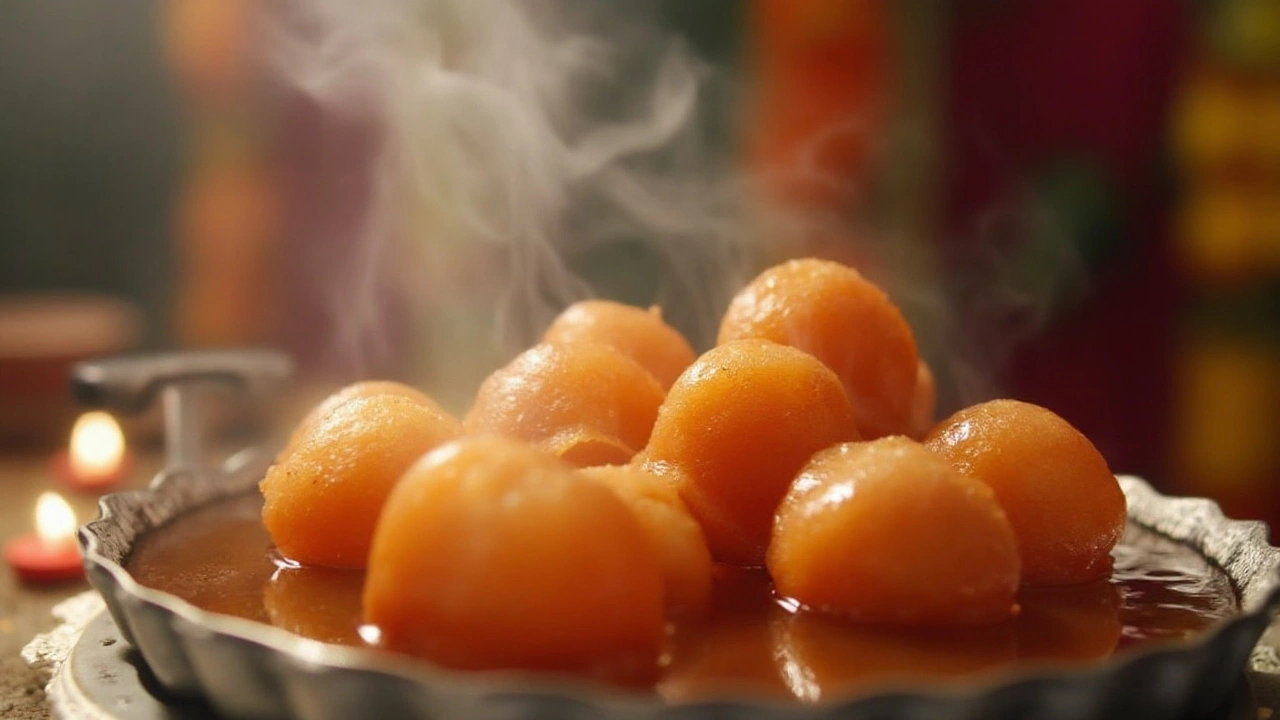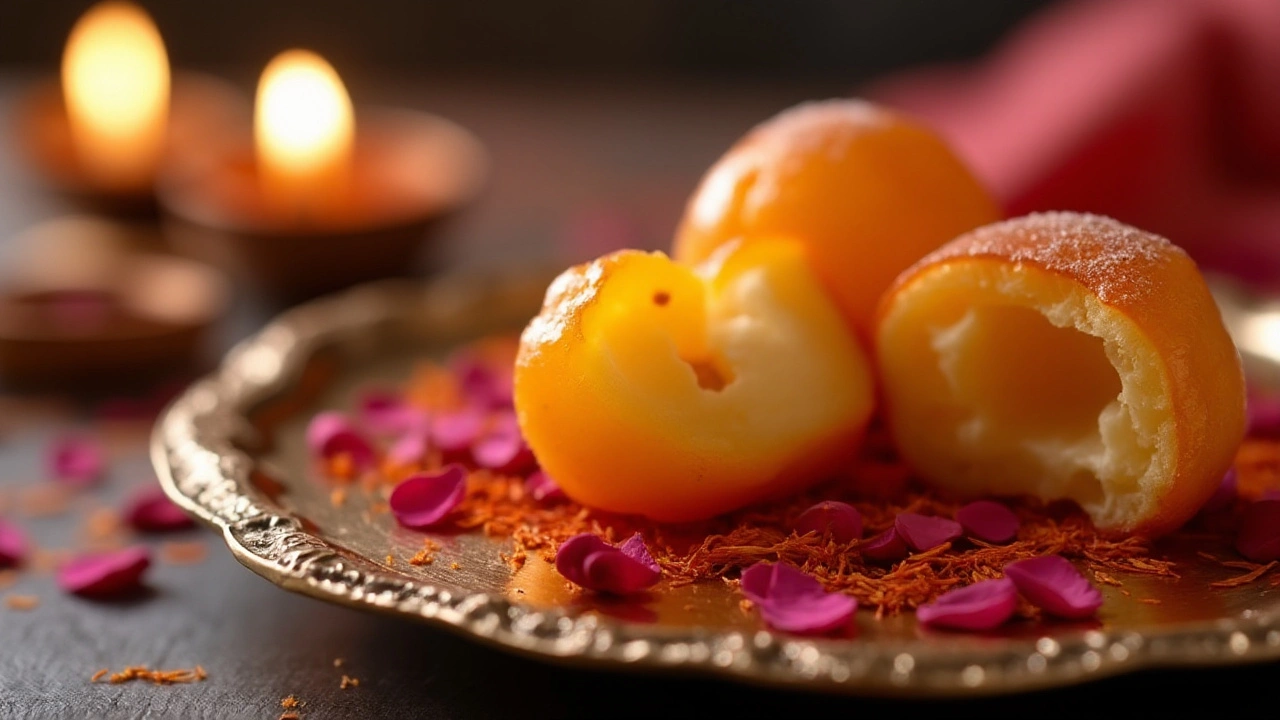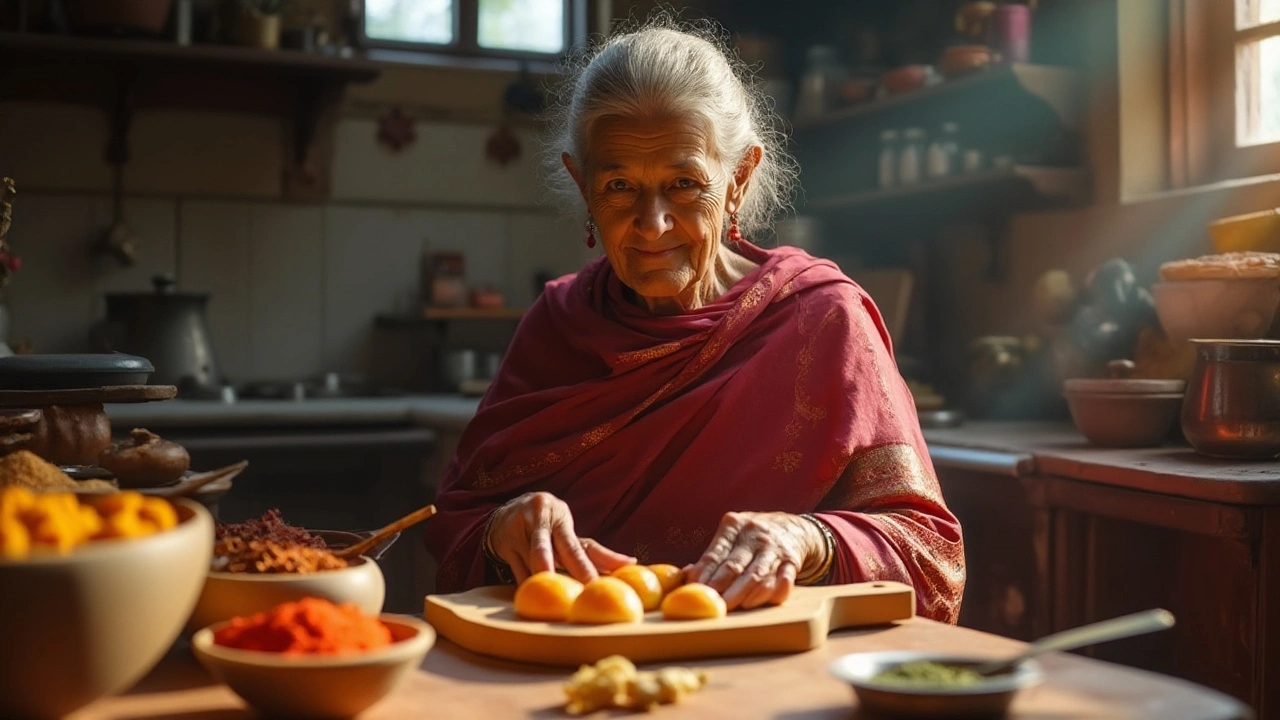19 Dec 2024
- 0 Comments
When it comes to Indian sweets, one name that immediately brings a smile to many faces is Gulab Jamun. These luscious orbs, bathed in a fragrant syrup, are cherished across the country and beyond. But what makes this sweet such a staple in Indian cuisine?
Originating from ancient Persia and finding its way to the Indian subcontinent through the Mughal kitchens, Gulab Jamun has an intriguing past that’s worth exploring. Today, each bite offers a taste of history, flavored with tradition and nostalgia.
Whether you're at a grand wedding, a festive celebration, or just indulging in a sweet craving, Gulab Jamun is often the star. With this article, let's dive deep into its delightful world. We'll uncover its origin, discuss what's needed to prepare this delicacy, explore regional spins, and give you tips to make it just right at home.
- History and Cultural Significance
- Ingredients and Preparation
- Variations Across Regions
- Making Perfect Gulab Jamuns at Home
History and Cultural Significance
The luscious Gulab Jamun holds a deep-rooted history in the annals of Indian gastronomy. It is believed to have evolved from a Persian dish called ‘Luqmat al-Qadi’ brought to India by the Mughals. The word ‘Gulab’ translates to rose in Persian, while ‘Jamun’ is a type of berry indigenous to the subcontinent, akin to the dessert’s appearance and color. This sweet has transcended time and geographies, becoming an emblem of joyous celebrations and gatherings in Indian households.
One could argue that Gulab Jamun is more than just a dessert; it is a witness to countless historical happenings. During the Mughal era, it was a delicacy in the royal kitchen, reserved for the elite. Over centuries, its popularity surged, making its way to every corner of the country. The brilliance of this sweet lies in its ubiquity; it’s present in every festive occasion – be it a wedding, Diwali, or Eid. This scrumptious creation, both simple and elegant, has solidified its place in Indian culinary tradition.
"Gulab Jamun is not merely a sweet; it is a celebration in itself," remarks Indian food historian K.T. Achaya, reflecting on its profound cultural impact.
Interestingly, the evolution of Gulab Jamun did not stop with the Mughals. Indian households ingeniously added local flavors, and often, it becomes an art of experimentation in various regions. For example, in Eastern India, stuffed versions with nuts and saffron are quite cherished, while in the Western counterparts, cardamom or sometimes even coconut-infused syrup is in demand. Such variations have added layers to its tangibility and cultural footprint.
It is not just a matter of taste but a cultural icon that connects generations through its timeless presence. An exciting aspect of Indian sweets like Gulab Jamun is their pop culture representation – from Bollywood movies to Indian literature. It symbolizes warmth, tradition, and the sweetness of life. Embracing not only a dish but an essence of celebrating togetherness, Gulab Jamun holds its charm unabated through generations.

Ingredients and Preparation
The crafting of Gulab Jamun is a harmonious blend of simple elements that transform into a lavish treat. The key ingredient, khoya, or reduced milk solids, is quintessential, providing that desired melt-in-the-mouth texture. Achieving the right khoya consistency requires patience—slow-cooked milk until it turns into a dense, rich paste. However, for modern convenience, many opt for ready-made khoya available in local Indian grocery stores. Gulab Jamun requires preparation of two main elements: the dough and the syrup. Let’s get a peek into these wonderful techniques.
To create Gulab Jamun, you'll need khoya, all-purpose flour, baking soda, and milk for the dough. A pinch of cardamom adds a subtle aroma. This is gently kneaded into a soft, dough-like consistency, ensuring no cracks on the surface of the Gulab Jamun balls. Make sure each ball is smooth before frying, as even a small crack can cause the balls to burst while frying. The frying should be done in ghee or oil, kept at a low to medium temperature, ensuring even cooking and that signature golden-brown finish.
Next comes the heart of Gulab Jamun—the syrup. Delicate yet flavorful, it's made by dissolving sugar in water, and infusing it with hints of rose water and cardamom for that exquisite essence that clings to the memory long after the last bite. Slow simmering of the syrup is vital, allowing the flavors to meld perfectly without caramelizing. A typical sugar to water ratio is 1:1, but adjust to taste. Once the syrup is ready, the warm Jamuns are gently submerged, soaking for an hour or more, allowing the syrup to infiltrate every pore.
Did you know? According to food historian Colleen Taylor Sen, "In its simplest terms, Gulab Jamun is a dessert that thrives on the power of absorption, much like a good story." These little nuggets of sweetness are not just about indulgence but also patience and precision. This dessert teaches the wisdom of slow living, savoring, and the magic of simple ingredients transformed into something truly fantastic. As the wise say, cooking is an art that grows with practice and patience.
Here's a quick look at the ideal quantities for accuracy:
| Ingredient | Quantity |
|---|---|
| Khoya | 250 grams |
| All-purpose flour | 2 tablespoons |
| Baking soda | 1/4 teaspoon |
| Milk | As needed |
| Sugar | 500 grams |
| Water | 500 ml |
| Rose water | 1 tablespoon |
| Cardamom | 4-5 pods |
The process may sound elaborate, but it's in this patience where the simple foods turn into rich traditions. The joy of creating Gulab Jamun is not just in its final form but in every step of its making, bringing a sense of accomplishment and an aroma that warms the heart, reminding once again that the simplest ingredients often hold the power to offer profound satisfaction.

Variations Across Regions
The aromatic and delectable Gulab Jamun may seem uniform to the casual observer, but those familiar with its diverse tapestry know that it varies significantly across different Indian regions. Each area adds its unique touch, whether it's through ingredients, techniques, or presentation. This variety not only enriches the culinary experience but also tells the story of India's cultural and regional diversities, where local cuisines have evolved with both regional influences and historical connections to Middle-Eastern desserts like Luqaimat.
In North India, you might encounter Gulab Jamun made with khoya, which is reduced milk solids, offering a rich and creamy texture that simply melts in your mouth. People from this part of the country prefer their Gulab Jamuns soft, almost liquid on the inside, and soaked in a thicker syrup sometimes infused with hints of cardamom and saffron. These ingredients aim to provide a luscious balance, enhancing the sweet aroma of the dish itself. Interestingly, some sweet shops in Delhi and Lucknow craft a larger version called 'Raj Bhog,' where the Gulab Jamun can be as big as a tennis ball, filled with dry fruits and saffron strands inside.
Venture south to Tamil Nadu or Karnataka, and the intrigue continues. Here, they often employ powdered milk as the primary ingredient, resulting in Gulab Jamuns that are lighter and slightly spongier yet equally delightful. Some towns may add hints of rose-water in the context of the syrup, perfectly playing with the origin of the name 'Gulab,' which means rose. Heavy on the sweetness scale, Southern Gulab Jamuns are sometimes served with additional garnishes like edible silver leaf or chopped nuts to further enhance their already extravagant presentation. A Tamil sweet expert chef quoted,
"The subtle flavor of rose gives the Southern Gulab Jamun an ethereal quality that balances the intensity of sugar perfectly."
In the Eastern states such as West Bengal and Odisha, you encounter something even more intriguing – the 'Langcha,' a variation wherein the dough may incorporate chhena, a curdled milk base famous in Bengali sweets like Rasgulla. Langcha often carries a golden-brown hue and might be cylindrical instead of spherical. Odias take pride in a lighter syrup and sometimes add a pinch of cloves to underscore their regional flair. Meanwhile, Bengalis are known for their love of tampering with the recipe slightly to adapt it as per their palate, turning it sometimes into a delicacy that can be either served hot or cold, accommodating the season.
Add to this the Western touches from Maharashtra, where the sweet is often paired with a special 'purnachi karanja,' or sweet pastry, during festivals like Diwali, and you have a dessert that tells a story not only of culinary delight but of deep-rooted tradition and festival spirit. In Gujarat, Gulab Jamuns might come with a touch of chuno (baking soda) to cause a burst of flavor and lightness. Each production style reflects the adaptable nature of Indian sweets and their practitioners, always pushing the envelope while retaining the grounding in tradition.
The perplexing diversity of Indian sweets like Gulab Jamun offers a gateway to tasting layers beyond sweetness. Try traveling across the regions of this vast country, and each variation will enable you to discover another version of royal sweetness, deeply interwoven with local heritage and endless creativity. So, why not invite various Gulab Jamun styles to your dessert plate? Indulge in exploring these elegant differences, and savor their link to their originating locations. You’ll find these variations add a truly vivid taste of India onto your palette.

Making Perfect Gulab Jamuns at Home
There is something magical about making Gulab Jamun in your own kitchen. The process transcends basic cooking, turning culinary efforts into a fragrant ritual filled with anticipation. To begin, choosing the right ingredients is paramount. The foundation of any compelling gulab jamun is the khoya, also widely known as milk solids, which imparts the dish its distinct rich texture and flavor. Freshness is key here, as aged khoya can lead to undesirable, crumbly results. Many rely on store-bought options, but if you’re feeling adventurous, making your own khoya can elevate the flavor profile immensely.
With ingredients in hand, focus shifts to the syrup preparation. The syrup is not just a sweet concoction, but an aromatic brew that perfumes the senses with its rose and cardamom infusion. A combination of sugar, water, rose water, and cardamom should be simmered until slightly sticky—not too thick or thin. This delicate balance ensures that your gulab jamuns absorb the right amount of syrup, achieving that luscious sweetness. An interesting fact—a perfect syrup helps in keeping the gulab jamuns soft even after they cool down, retaining their melt-in-mouth quality.
The shaping and frying of these sweet spheres is akin to an art form. When forming the dough into balls, aim for uniformity to ensure even cooking. Rolling the dough gently between your palms, without any cracks, is essential to prevent them from breaking during frying. The frying process is equally crucial; patience is your best friend here. A medium-low flame allows for a gradual golden color to develop, ensuring the insides are cooked perfectly while the exterior is crisp and inviting.
Once golden brown, immediacy in transferring the fried gulab jamuns into the warm syrup ensures they soak properly. Letting them sit and absorb the syrup is a practice long endorsed by traditionalists and for good reason. Allow the gulab jamuns to rest in the syrup for at least two hours before serving.
“A masterstroke in any cultural meal is finishing with a dessert that resonates with the very ethos of that culture. Gulab jamun, with its universal appeal, does exactly that.” — Chef Vikas KhannaDuring this rest, they become incredibly tender, absorbing flavors far beyond simple sweetness.
Before you present them to your eager guests or savor a quiet moment with a serving yourself, consider a delicate garnish. Lightly toasted almond slivers or saffron strands can introduce a delightful contrast, adding visual allure and textural intrigue. These seemingly minor additions can elevate the presentation, turning a humble dessert into a show-stopping centerpiece. With these steps and tips in mind, creating Indian sweets like Gulab Jamun at home becomes a rewarding dance of flavors and technique, a true testament to the art of Indian dessert making.
